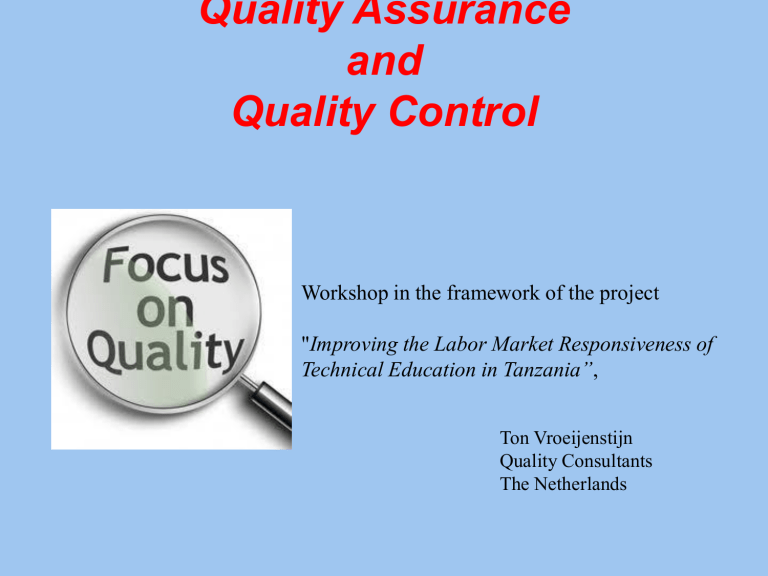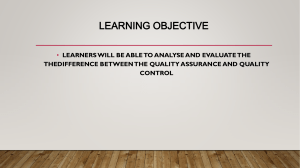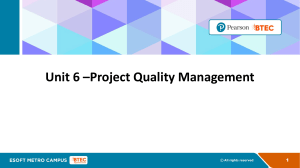
Quality Assurance and Quality Control Workshop in the framework of the project "Improving the Labor Market Responsiveness of Technical Education in Tanzania”, Ton Vroeijenstijn Quality Consultants The Netherlands Program 1. Do we speak the same language? 2. Towards an Internal Quality Assurance system 3. How to discover the quality of the Institution? 4. How to discover the quality of a program? 5. The IUCEA handbook and the TI’s Expected learning outcomes After the workshop, it is expected that you will be able: to describe the concepts of “quality” and “quality assurance” in Higher Education to participate in the on-going discussion about quality to discover the quality of your institution by means of a self assessment To discover the quality of a program part 1 “Do we speak the same language?” 4 What is Quality? Basic questions concerning quality What is quality? Who are the players in the quality game? Can quality be measured? (Criteria and standards) Who set the standards? how do we know the quality? 6 HIGHER EDUCATION Players in the quality field students staff Government / parliament employers/professional bodies NACTE international forum 7 DIFFERENT VIEWS ON QUALITY Quality is the satisfaction of the client Quality as excellence Quality as additional value Quality as value for money Quality as fitness for purpose Quality as meeting threshold standards 8 Quality Absolute Quality does not exist There is no fixed definition of Quality View on Quality is changing in time But we must find a workable concept, shared by all 9 Stakeholders and Quality 10 Quality is • achieving our goals and aims in an efficient and effective way (fitness for purpose), • assuming that the goals and aims reflect the requirements/expectations of all our stakeholders in an adequate way (fitness of purpose). 11 CBE Quality control and Assurance policy the term quality refers to “fitness for purpose” (i.e. the institution and its components of activities have “quality” if they conform to the purpose for which they were designed). Quality Is context based But there is always a threshold quality International standards University of the Amazonas University Rio de Janeiro Berkeley National standards 13 Criteria & standards Criterion: the specification of elements against which a judgment is made a specific aspect, essential for the quality Standard: the level that a criterion must reach. Normally: adequate or satisfactory. Sometimes quantifiable 14 Criteria & standards Who is setting standards? Who is checking the standards? Because there is no absolute quality, there are no absolute standards; standards are a matter of negotiation. Criteria: valid in all circumstances Standards: context bound: Mc Donald and 3 stars restaurant 15 Can Quality be measured? Tendency of governments to quantify quality aspects Use of performance indicators? But….performance indicators does not tell us all about the quality “Performance indicators may harm the quality” 16 Performance indicators and quality assessment Acidity % alcohol tannin sediment performance indicators smell taste expert team 17 Without quality assurance, no TI will survive QA in Industry TQM-Deming cycle ISO EFQM Quality Assurance in HE a process of establishing stakeholder confidence that provision (input, process and outcomes) fulfils expectations or measures up to threshold minimum requirements. (Harvey, 2004, Analytic Quality Glossary) Systematic, structured and continuous attention to quality in terms of maintaining and improving quality. ( IUCEA handbook A Roadmap to quality) Why Quality assurance is needed More students, less money Rise of private institutions Growing competition Changing expectations labour market Globalisation Tax payer want value for money “ Consumer” protection Quality management in Higher Education • • • • • Formal EQA Accreditation Informal External QA Audit Assessment benchmarking Internal QA planning monitoring : improvement evaluation Internal Quality Assurance IQA is: Systematic, structured and continuous attention to quality in terms of maintaining and improving quality in research, community service, instruction Plan Act Do Check Key-questions Do we do the right things? Do we do the right things in the right way? Do we have a thorough command of the process to realize actually what we want? Do we really achieve what we want to achieve? 24 What instruments do we have for IQA?? Monitoring systems: Student progress Pass rates/drop outs Structural contacts employers Structural contact alumni Evaluation instruments Student evaluation Course evaluation Curriculum evaluation Improvement instruments: Staff development activities Curriculum design SWOT-analysis/self assessment External assessment Implementation IQA-system there is no one fit for all IQA system is tailor made, but …. Requirements set by out side agencies Code of good practice ENQA, INQAAHE, UNESCO 26 CRITERIA FOR IQA (enqa) 1 Policy and procedures for QA 2 Monitoring system 3 Periodic review of the core activities 4 Quality assurance of the student assessment 5 Quality assurance of staff 6 Quality assurance of facilities 7 Quality assurance of the student support 8 Self assessment 9 Internal audit 10 Information systems 11 Public information 12 A Quality handbook 27 Basic conditions for IQA As simple as possible and not bureaucratic Balance between centralized and decentralized approach Supported by management Effective instruments Tuned to national and international developments 28 Problems with the introduction of IQA Lack of quality awareness Resistance against innovations Resistance of staff because they feel threatened Lack of knowledge about QA. Training is needed. resistance because it is time consuming and money consuming (“We have other things to do”). It is difficult to define what quality is; the QA indicators are not always clear; The purpose and the added value are not always clear Lack of clear communication between the staff and the institutions management 29 To overcome the problems it is important to: Understand clearly what Quality Assurance means; Know the available instruments; Know about the requirements set for an IQA system Design the system very clearly and formulate the strategy to introduce it Tune the system to external developments. 30 1. QA-0rganisation and procedures 1.1. QA-unit & committees 1.2. Quality(improvement plan) 2 Student Progress 3 Pass rates Drop out rates 4 Feedback Labour market & Alumni Evaluation instruments 6 Student evaluation 7 Course/curriculum evaluation 8 Research evaluation Special QA processes 10 Assurance Quality student assessment 11 Assurance Quality staff 12 Assurance Quality Facilities & infrastructure Monitoring instruments Specific QA instruments 14 SWOT-analysis Self assessment 15 Inter-collegial audit or Peer review 16 Information systems 18. Follow up activities 5 Research Performance 9 Community Service evaluation 13 Assurance Quality Student support 17 Quality handbook Self-assessment: a powerful instrument Analysis of the quality of the institution/faculty/department/program Promotion of quality awareness and strengthening the ”corporate identity” Providing information to the external expert team CONDITIONS FOR SELF ANALYSIS A self assessment: should never be felt as threatening aims at improvement and enhancement need a broad support; Everybody has to be involved. Need support of the management demands a good organisation. is an analysis supported by the whole faculty Not everyone has to agree with all the points in the selfassessment report. Part 3 How to discover the quality of the institution? 1. Requirements stakeholders 3 Policy plan 2 Mission Vision 4 Leadership & administration 5 Human resource • • • • • • • 8 Educational Effectiveness The program Student assessment Staff Student admission Facilities Infrastructure Partnership HEI’s 10 benchmarking Aims Objectives 6 Funding & Financial management 7 Facilities & Infrastructure 11 Quality assurance 9 Community contribution 13. Satisfaction stakeholders 12 A C H I E V E M E N T S Academic standards NACTE Standard 1: Institutional Vision and Mission; Standard 2: Governance and Administration; Standard 3: Institutional Integrity; Standard 4: Institutional Effectiveness; Standard 5: Educational Programmes; Standard 6: Student Information and Admission to Programmes; Standard 7: Student Guidance and Support; Standard 8: Staff Selection, Appraisal and Development; Standard 9: Physical Resources; and Standard 10: Financial Resources. Quality criteria at Institutional level IUCEA •Philosophy, Mission, vision, of the institution •Policy plan •Governance •Human Resource •Funding and Financial Management •Educational activities •Research •Community outreach •benchmarking •Quality assurance •Achievements/outcomes •Satisfaction of the stakeholders 36 1. Requirements stakeholders 3 Policy plan 2 Mission Vision 4 Leadership & administration 5 Human resource 8 Educational Effectiveness •The program •Student assessment •Staff •Student admission •Facilities •Infrastructure •Partnership HEI’s 10 benchmarking Aims Objectives 6 Funding & Financial management 7 Facilities & Infrastructure 11 Quality assurance 9 Community contribution 13. Satisfaction stakeholders 12 A C H I E V E M E N T S part 4 How to discover the quality of our programs?? A program is defined as a coherent set of courses leading to a certain degree (bachelor or master). We may call the program also a curriculum It is not only about the content, but also about the process and the boundary conditions Program/ curriculum I nstitutional capacity 1. Mission & objectives 2 Leadership & Administration 3. Financial Resources 5 E X P E C T E D L E A R N I N G O U T C O M E S 4.Requirements stakeholders Process Input Quality Assurance 6 Programme specificatio n 7 Content of the programme 8 Organization the programme 9 Didactic concept 11 Quality Academic staff 12 Quality Suppor t staff 13 Profile Of students 14 Student Advice & suppor t 16 Student evaluation 17 Curriculum design 18 Staff development activities 10 Student Assessment 15 Facilities & Infrastructu re 19 Benchmarking 21.Satisfaction stakeholders 22.Par tnership with HEI’s 23 Research 24 Community service 20 Achievements: The graduates Criteria to be assessed •Goals and objectives; expected learning outcomes •Program content •Program specification or description •Program organisation •Didactic concept/teaching/learning strategy •Student assessment •Staff quality •Quality of the support staff •Student profile •Student advice/support •Facilities & infrastructure •Student evaluation •Curriculum design & evaluation •Staff development activities •Benchmarking •Achievements /graduates •Satisfaction stakeholders Program/curriculum Institutional capacity 1. Mission & objectives 2 Leadership & Administration 3. Financial Resources 5 E X P E C T E D L E A R N I N G O U T C O M E S 4.Requirements stakeholders Process Input Quality Assurance 6 Programme specification 7 Content of the programme 8 Organization the programme 9 Didactic concept 11 Quality Academic staff 12 Quality Support staff 13 Profile Of students 14 Student Advice & support 16 Student evaluation 17 Curriculum design 18 Staff development activities 10 Student Assessment 15 Facilities & Infrastructur e 19 Benchmarking 21.Satisfaction stakeholders 22.Partnership with HEI’s 23 Research 24 Community service 20 Achievements: The graduates Strengths and weaknesses analysis 1 1 Goals and objectives; expected learning outcomes 2 Programme content 3 Programme specification 4 Programme organisation 5 Didactic concept/teaching/learning strategy 6 Student assessment 7 Staff quality 8 Quality of the support staff 9 Student profile 10 Student advice/support 2 3 4 5 6 7 x x x x x x x x x 41 The 7-point scale read as follows 1= absolutely inadequate; immediate improvements must be made 2= inadequate, improvements necessary 3= inadequate, but minor improvements will make it adequate 4= adequate as expected 5= better than adequate 6= example of good practice 7= excellent The follow-up of the self-assessment In many cases followed by accreditation If not: organize an inter-collegial assessment Outcomes of the SWOT-analysis is used for a quality plan Each year check of the quality plan Impact Does al efforts put in Quality Assurance have impact? Difficult to measure Different views on quality QA is one of the activities effecting HE Methodological problem: no comparison how it was before “Students do not perform better” There are changes, but “we had already planned this before. Some changes Shift from research oriented to education oriented Individual courses ------ curriculum as a joint enterprise Teacher oriented --------student oriented Better structured curricula; learning outcomes People start to think about qulity Negative Teacher perceive is as a bureaucratic burden Compliance culture Hindering innovation Ritual dance Window dressing Part 5 The IUCEA handbook Why an IUCEA quality handbook was seen as needed Development in the region of a shared idea of quality harmonized internal quality assurance systems a shared idea about criteria and standards shared ideas about the accreditation framework A Road Map to quality Initiative of the IUCEA 2006, supported by DAAD and HRK of Germany Based on documents and experiences of the national regulatory bodies in East Africa Based on similar developments in South-East Asia, Central America and Europe Editorial board with members of the standing committee of the IUCEA Discussion of drafts at the different workshops 5th draft used by the 1st cohort of universities Revised draft (4 volumes ) by 2nd cohort Endorsed by IUCEA and official publication June 2009 (www.iucea.org) Contents of the handbook Volume 1 Guidelines for Self- assessment at program level aims at the faculty/department offering an instrument to learn more about the quality of the programs at offer by means of an effective self assessment at program level Volume 2: Guidelines for external assessment explains the procedures and processes for an external assessment at program level. The specific target group is the external expert team, but also the faculty/department to be assessed. Volume 3: Guidelines for Self-assessment at institutional level aims especially at the central management of an institution and offers an instrument to discover more about the quality of the institution Volume 4: The implementation of a Quality Assurance system aims at all level of an institution, but is especially useful for the Quality Assurance coordinators for the development and installation of an Internal Quality Assurance system How to use the handbook 1. The handbook is not forcing an institution to apply fixed standards and ideas 2. It is voluntary, but…….. members of IUCA should play the rules of the game 3. For private institutions: it will help to be in line with international developments 4. The handbook offers a toolkit for quality assurance and quality improvement. 1. Central management can use the handbook to discuss and implement a quality policy 2. The Quality-officer can use the handbook to promote quality assurance in the institution and to facilitate the quality process in the university. The handbook contains basic materials for training sessions. 3. Faculty deans can use the instrument for self assessment at program level and provide staff and students with basic background information 4. Staff and students can use the handbook for better understanding of the need of quality assurance and also for a better understanding of the instruments. . Some statements 1.Responsibility for quality assurance should be replaced: more efforts from the TI’s, less from NACTE 2.It is advisable to develop a handbook for quality assurance, based on the Roadmap, to be used by the TI’s 3.NACTE will bring its process, procedures and . publications in line with the handbook



